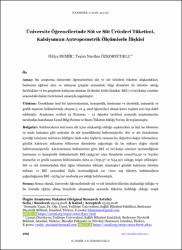| dc.contributor.author | Demir, Hülya | |
| dc.contributor.author | Özkorucuklu, Yeşim Nurdan | |
| dc.date.accessioned | 2018-12-12T09:33:58Z | |
| dc.date.available | 2018-12-12T09:33:58Z | |
| dc.date.issued | 2018-08-31 | |
| dc.identifier.issn | 2536-4499 | |
| dc.identifier.issn | 2602-2605 | |
| dc.identifier.uri | https://hdl.handle.net/11363/622 | |
| dc.description.abstract | Amaç: Bu araştırma üniversite öğrencilerinin süt ve süt ürünleri tüketim alışkanlıkları, beslenme eğitimi alan ve almayan gruplar arasındaki bilgi düzeyleri ile tüketim sıklığı farklılıkları ve bu grupların kalsiyum alımları ile Beden Kütle İndeksi (BKİ) ve bel/kalça oranları arasındaki ilişkiyi belirlemek amacıyla yapılmıştır. Yöntem: Örnekleme özel bir üniversitesinin, hemşirelik, beslenme ve diyetetik, mimarlık ve grafik tasarımı bölümlerinde okuyan 3. ve 4. sınıf öğrencileri olmak üzere toplam 200 kişi dahil edilmiştir. Araştırma verileri 15 Temmuz – 15 Ağustos tarihleri arasında araştırmacılar tarafından hazırlanan Genel Bilgi Formu ve Besin Tüketim Sıklığı Formu ile toplanmıştır. Bulgular: Katılımcıların 109’unun süt içme alışkanlığı olduğu saptanırken 91 kişi ise tiksinme ve mide bulantısı gibi nedenler ile süt içmediklerini belirtmişlerdir. Süt ve süt ürünlerinin içerdiği kalsiyum miktarını bildiğini ifade eden kişilerin tamamı bu değerleri doğru bilemezken, günlük kalsiyum miktarını biliyorum diyenlerin çoğunluğu da bu miktarı doğru olarak belirtememişlerdir. Katılımcıların bölümlerine göre BKİ ve bel/kalça oranları incelendiğinde beslenme ve hemşirelik bölümlerinde BKİ>25kg/m2 olan bireylerin oranı(%3,92 ve %9,80) mimarlık ve grafik tasarımı bölümünden daha az (%31,37 ve %54,90) olduğu tespit edilmiştir. Süt ve süt ürünlerinden (her öğün tüketenler dikkate alınmıştır) günlük kalsiyum tüketim miktarı ve BKİ arasındaki ilişki incelendiğinde ise <600 mg tüketen katılımcıların çoğunluğunun BKİ >25 kg/m2 sınıfında yer aldığı belirlenmiştir. Sonuç: Sonuç olarak, üniversite öğrencilerinde süt ve süt ürünleri tüketim alışkanlığı olduğu ve bu konuda eğitim almış bireylerle almamışlar arasında tüketim farklılığı olduğu tespit edilmiştir. Katılımcıların yetersiz süt ve süt ürünleri tüketimi ile yüksek Beden Kütle İndeksi ve bel/kalça oranı arasında negatif ilişki olduğu saptanmıştır. | en_US |
| dc.description.abstract | Aim: This study was carried out to determine the relation between the consumption habits of milk and dairy products of the university students, the knowledge levels of groups receiving nutrition education and those not, and the calcium intake, Body Mass Indexes and waist/hip ratios of these students. Method: Sampling included a total of 200 students from Yeditepe University, consisting of 3rd and 4th grade students studying in Nursing, Nutrition and Dietetics, Architecture and Graphic Design departments. The study data were collected between 15 July and 15 August with the General Information Form and the Food Consumption Frequency Form. Findings: While 109 participants were determined to have a habit of drinking milk, 91 participants stated that they did not drink milk for reasons such as disgust and nausea. While all of the participants who claim that they know the amount of calcium contained in milk and dairy products could not guess these values correctly, the majority of those who state that they know the amount of daily calcium cannot accurately state this amount. When body mass indexes and waist/hip ratios of the participants are analyzed according to the departments, it was determined that the proportion of individuals with a body mass index of 25 kg/m2 in the nutrition and nursing departments is less than that of the department of architecture and graphic design. When the relation between the amount of daily calcium from milk and dairy products (taking into account daily and every meal consumptions) and the body mass indexes is observed, it is detected that the body mass index of the majority of participants consuming <600 milligrams is in >25 kg/m2 class. Conclusion: As a result, it was determined that the university students have different consumption habits of milk and dairy products and there was a difference in consumption among those who have received education in this regard and those who have not. It was detected that there was a negative relation between inadequate consumption of milk and dairy products, high body mass index and waist/hip ratio in the participants. | en_US |
| dc.language.iso | tur | en_US |
| dc.publisher | İstanbul Gelişim Üniversitesi Yayınları / Istanbul Gelisim University Press | en_US |
| dc.rights | info:eu-repo/semantics/openAccess | en_US |
| dc.subject | Research Subject Categories::MEDICINE | en_US |
| dc.title | Üniversite Öğrencilerinde Süt ve Süt Ürünleri Tüketimi, Kalsiyumun Antropometrik Ölçümlerle İlişkisi | en_US |
| dc.title.alternative | Relation of Consumption of Milk and Dairy Products in the University Students, Calcium with Anthropometric Measurements | en_US |
| dc.type | article | en_US |
| dc.relation.publicationcategory | Makale - Ulusal Hakemli Dergi - Kurum Yayını | en_US |

















